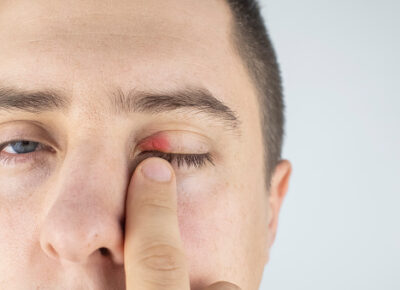
A stye (also called a hordeolum) is a small, red, painful lump that grows from the base of your eyelash or under the eyelid. Most styes are caused by a bacterial infection.
There are two kinds of styes:
-
External hordeolum: A stye that begins at the base of your eyelash. Most are caused by an infection in the hair follicle. It might look like a pimple.
-
Internal hordeolum: A stye inside your eyelid. Most are caused by an infection in an oil-producing gland in your eyelid.
You can also get a stye if you have blepharitis. This is a condition that makes your eyelids at the base of the eyelashes red and swollen.
When you first get a stye, your eyelid is probably red and tender to the touch. Your eye may also feel sore and scratchy.
A chalazion is a swollen bump on the eyelid. It happens when the eyelid’s oil gland clogs up. Sometimes stress can cause these types of eyelid issues to happen; many people were getting styes/chalazia during the COVID pandemic. Chalazion may start as an internal hordeolum (stye). At first, you might not know you have a chalazion as there is little or no pain. But as it grows, your eyelid may get red, swollen, and sometimes tender to touch. If the chalazion gets large, it can press on your eye and cause blurry vision. Rarely, the whole eyelid might swell.
Treatments for chalazia/styes can include warm compresses, antibiotics, steroid injections and surgery. Surgery can be done in the office. As with any surgery, it is important that blood thinner use be stopped several days/weeks before the procedure to minimize bleeding. Usually the patient leaves the office with a bandage on their eye and a prescription for antibiotics. Depending on the size of the chalazion/stye, stiches may be required. The tissue will be sent to a pathology lab to make sure there is nothing more insidious occurring.